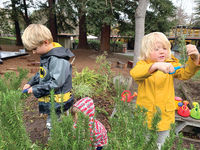
By Jessica Predom, Teacher
As Center Room approached the end of the winter quarter, the sun began to remind us that spring was on the way. Springtime signifies an opportunity to celebrate growth, both in our natural environment as well as in our classroom. Our garden bed, lush with overgrown greens, provided an invitation for children, ages 3 to 5, to demonstrate some of their newly mastered fine motor and gross motor skills. Our afternoon class collaborated with the morning class on the garden. Coming together initially to trim pieces of the overgrown flora, children became excited and very dedicated to the ongoing task of renewal. Once the sheath of overgrowth was clipped, children showed perseverance and strength as they wielded their shovels to dig deeply into the soil, unearthing root structures, bulbs, worms and insects. Children dug cautiously, slowly removing each specimen for further inspection. Worms became the children’s honored guests and were treated to a myriad of delights. Children prepared residences for the worms out of containers with magnifying lenses in the lids and filled with soil and carefully selected leaves. Children toted their worms in wheelbarrows and gave them the grand tour of the yard, introducing them to other children along the way.
There was a collective pride in our classroom garden. Transforming the space brought children together to sow seeds and grow plants, which will surely inspire future projects and experiments in Center Room.
Planting Seeds
As the children gazed upon the open garden plot, they began to collectively dream of the possibilities. The open soil inspired inquiry, brainstorming and collaboration among the children and adults in our community. Children thought deeply about the kinds of plants that were important to them. Many of their ideas were motivated by their love for our outdoor environment. Together they lobbied for carrots to feed the rabbits, vegetables to enjoy at the snack table, and flowers to bring cheer to us all. Children planted radishes, peas, carrots, peppers, lavender, California poppies and snapdragons. They also found new places to plant all the daffodil bulbs discovered during tilling.
Caring for the Garden

Once the seeds lay in their newly blanketed beds and the bulbs had been tucked neatly beneath the soil, children took turns watering the garden. After planting, the soil looked nearly the same as it had before. Children grew curious and asked with concern, “How will we know where our seeds are?” In order to protect the seedlings, children began creating signs to indicate which areas in the garden were occupied by each seed. Children carefully observed the images from the seed packaging in order to prepare labels.
Creating Space to Explore
Navigating the garden became a challenging task as the seeds lay hidden under the soil. In a further demonstration of their empathy for the plants, children did their best to tiptoe around their new seedlings. It became evident that the children needed a clear pathway to continue exploring the environment they had created. Employing clay, one of the basic, open-ended materials commonly used as a foundation of the Bing curriculum, children constructed stepping-stones to indicate a path. Children created individualized pieces, using their hands to flatten the clay into the desired shape. Some children pressed leaves and pinecones into the clay while others drew intricate designs with tools and sticks. Paloma Moreno, one of the teachers in Center PM, toted nearly 50 stones to be fired in a kiln provided through a ceramics class she was taking at Foothill College. The final layout of the stones resembled city roadways, allowing access to every section of the garden.
Watching the Transformation
“Let’s go to the garden and not do anything else for the rest of the day.” —Dominic
For three weeks, children arrived at school excitedly asking, “What is happening in the garden today?” Children began to notice green buds and thin stalks popping up from beneath the soil. They eagerly watered those spaces, making sure to tend to their new responsibility. Children were also eager to show their parents and caregivers how they had contributed at the end of the day. Children drew pictures and kept records of the transformation they observed. The teachers marveled at the children’s increased comfort and confidence in working on collaborative projects with a larger group and their rising sense of responsibility toward the shared physical space.